Mold Removal and How to Kill Mold
Mold Removal Products
There are several products you can use to kill and remove mold. Some of the most effective mold removal products include:- Bleach
- Borax
- Vinegar
- Ammonia
- Hydrogen peroxide
- Detergent
- Baking soda
- Tea tree oil
- Grapefruit seed extract
The How to Kill Mold on Drywall, Wood, Carpet, Tiles and Grout page also provides instructions for removing mold from specific materials.
The Mold Remediation page gives a step by step guide to remediating large mold problems. It covers protective equipment, spore containment, killing the mold, preventing the mold's return, mold disposal and final clean up.
Mold Removal with Bleach
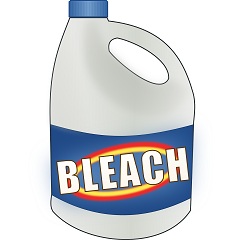
Bleach can kill virtually every species of indoor mold that it comes into contact with, along with its spores, leaving a surface sanitized and resistant to future mold growth.
Unfortunately, however, using bleach is only effective if the mold is growing on non-porous materials such as tiles, bathtubs, glass and countertops. Bleach cannot penetrate into porous materials and so it does not come into contact with mold growing beneath the surface of materials such as wood and drywall. Using bleach on these materials will kill the mold above the surface but the roots within the material will remain and the mold will soon return.
How to Kill Mold with Bleach
Bleach produces harsh fumes so make sure the area is well ventilated before you begin. You should also wear gloves during the process to protect your hands.- For killing mold with bleach use a ratio of one cup of bleach per gallon of water (ie about 1 part bleach to 10 parts water).
- Apply the solution to non-porous surfaces with mold growth either by using a spray bottle or by using a bucket and a sponge or cloth.
- You don't need to rinse the surface afterwards (unless it is used for food preparation or a surface which may be touched by small children or pets) as the bleach will inhibit mold growing in the future.
Does Bleach Kill Mold?
Although the active ingredient in bleach, sodium hypochlorite, is the main ingredient in many mold removal products, there are many reasons to use alternatives to chlorine bleach when killing mold.One reason is that bleach cannot completely kill mold growing in porous materials. The chlorine in bleach cannot penetrate into porous surfaces such as drywall or wood. The chlorine is left on the surface of porous materials and only the water component of the bleach is absorbed into the material, providing more moisture for the mold to feed on.
Some of the mold on the surface might be killed but the roots of the mold are left intact meaning the mold soon returns, leaving you in a cycle of repeated bleaching. Perhaps this is why some people believe that spraying bleach on mold doesn't affect it but instead just bleaches its color so you can no longer see it.
Another disadvantage of bleach is that it can damage the materials it's used on as it is a harsh, corrosive chemical. Chlorine bleach also gives off harsh fumes and it even produces toxic gas when mixed with ammonia. There are safer alternatives such as borax or vinegar which don't produce dangerous fumes or leave behind toxic residue. For these reasons try to avoid using bleach and if you must use it, only use it on non-porous surfaces.
Mold Removal with Borax
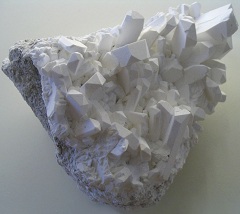
There are many advantages to using borax to kill mold. For starters, borax is a natural cleaning product and although it is toxic if you swallow it, borax does not emit chemicals or dangerous fumes like some other mold killers. Borax, a white mineral powder, has a pH level of about 9 (baking soda is pH 8.1 and pH 7 is neutral) and a low toxicity.
Borax is commonly used as a deodorizer as well as for cleaning toilets and drains. Borax is also used as an insecticide, herbicide and fungicide and it can be mixed with water in a solution to kill and remove mold as it is a natural mold inhibitor. You can buy borax in supermarkets for a few dollars from the laundry section.
How to Kill Mold with Borax
- To kill mold using borax, create a borax-water solution using a ratio of 1 cup of borax per gallon of water.
- Vacuum up any loose mold with a HEPA filtered vacuum cleaner to lessen the number of spores stirred up into the air during the cleaning process.
- Use a scrubbing brush with the borax-water solution to scrub the mold off the surface.
- Wipe up any extra moisture and excess mold particles or dust/debris to prevent them spreading into the air once the surface has dried.
- You don't need to rinse off the borax as the solution will prevent more mold beginning to grow on the surface again.
- Leave the surface to dry completely.
Mold Removal with Vinegar
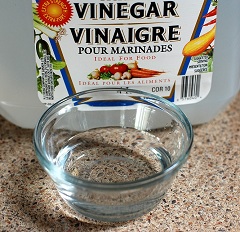
Vinegar is a mild acid which can kill 82% of mold species. However it also has the advantages of being natural and safe. Vinegar is non-toxic and doesn't give off dangerous fumes like bleach does.
How to Kill Mold with Vinegar
To kill mold with vinegar, use white distilled vinegar which you can buy cheaply from the supermarket.- Pour some vinegar into a spray bottle without watering it down.
- Spray the vinegar onto the moldy surface and leave it to sit for an hour.
- Wipe clean the area with water and allow the surface to dry. Any smell from the vinegar should clear within a few hours.
If you want to use vinegar to prevent mold growing on surfaces just spray vinegar on the surface and leave it. Repeat this every few days to ensure the surface will stay mold-free. You can even mop your tiled bathroom floor or other hard non-porous floors with vinegar if you are worried about mold growing on them.
Mold Removal with Ammonia
Like bleach, ammonia will kill mold on hard non-porous surfaces such as countertops, glass or tiles but it is ineffective at killing mold growing in porous material such as wood or drywall.Another disadvantage of using ammonia is that it is a harsh, toxic chemical. Make sure you never mix ammonia with bleach because the gas they create when combined is toxic. Chlorine mixed with ammonia was even used as a chemical weapon during World War 2.
Additionally, although ammonia can kill surface mold, dead mold and dead mold spores are still allergenic so you will need to make sure to remove them afterwards.
How to Kill Mold with Ammonia
- To kill mold using ammonia, create a solution of 50% clear ammonia and 50% water in a spray bottle and spray it on moldy areas.
- Make sure the ammonia you use says "clear ammonia" on the label.
- Leave the area for a few hours before wiping and rinsing.
- Often detergents or mold cleaning products will contain ammonia. In that case just follow the directions on the label and be sure never to mix it with bleach.
Mold Removal with Hydrogen Peroxide
Hydrogen peroxide kills mold as it is anti-fungal as well as anti-viral and anti-bacterial. Hydrogen peroxide is a good alternative to chlorine bleach because it is safe to use and doesn't damage the environment, nor does it leave behind toxic residue or produce toxic fumes like chlorine bleach does. You can buy hydrogen peroxide from drug stores for around one dollar for a bottle of 3% concentration.Hydrogen peroxide kills mold effectively on many materials such as clothes, floors, bathroom fixtures, walls and items such as kitchen appliances. Since hydrogen peroxide is a bleaching agent it may also help fade the stain mold leaves behind. Spot test hydrogen peroxide on the material you're going to be cleaning to make sure it won't fade the material's colors.
How to Kill Mold with Hydrogen Peroxide
- To kill mold pour 3% concentration hydrogen peroxide into a spray bottle.
- Spray the moldy surface completely so that the moldy areas are saturated with hydrogen peroxide.
- Leave the surface to sit for 10 minutes while the hydrogen peroxide kills the mold.
- Then scrub the area to make sure to remove all the mold and mold stains.
- Finally wipe the surface down to remove residual mold and spores.
You can also use vinegar with hydrogen peroxide during the cleaning to more effectively remove the mold. Afterwards store the spray bottle in a dark place since light diminishes hydrogen peroxide's effectiveness.
Mold Removal with Detergent and Water
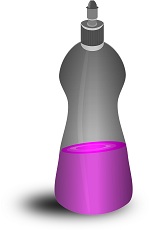
A solution of detergent and warm water can be used to scrub surface mold off non-porous surfaces. Although detergent itself doesn't kill mold, if the mold is on non-porous materials then the solution doesn't need to kill it as long as you completely clean away all the mold on the surface.
Mold Removal with Baking Soda
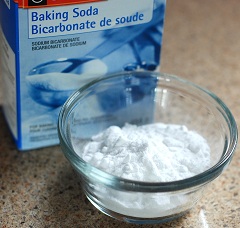
Baking soda is well known as a natural and safe household cleaner. But you can also use baking soda to kill mold in your home. Unlike other mold killers which contain harsh chemicals, baking soda is mild (pH of 8.1) and harmless to your family and any pets.
Besides killing mold, baking soda also deodorizes and so using it can get rid of the smell mold leaves in your home. Baking soda also absorbs moisture to help keep mold away.
Vinegar is often used along with baking soda when cleaning up a mold problem since vinegar kills different species of mold to baking soda.
How to Kill Mold with Baking Soda
- Add one quarter of a tablespoon of baking soda to a spray bottle of water.
- Shake the bottle to dissolve the baking soda into the water.
- Spray the moldy area with the baking soda and water solution.
- Then use a sponge or scrubbing brush to make sure to remove all the mold from the surface.
- Once you've scrubbed away the mold rinse the surface with water to remove any residual mold on the surface.
- Spray the area with the spray bottle again and let the surface dry. This will kill any left over mold and prevent the mold returning.
You can use a cloth instead of a spray bottle to clean mold with baking soda:
- Soak a cloth in water and then add one quarter of a tablespoon of baking soda to it.
- Use the cloth on the moldy area to remove the mold with the baking soda and water solution.
Mold Removal with Tea Tree Oil
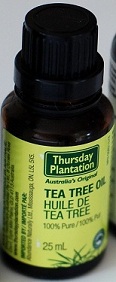
Of all the natural mold killing solutions tea tree oil is the most effective. Although it is also expensive, a small amount of tea tree oil goes a long way in killing mold.
Tea tree oil is an essential oil which is harmless to people and pets. Tea tree oil is antifungal, capable of killing all types of molds. Tea tree oil is antibacterial as well.
You can buy tea tree oil for about $10 for a small bottle from most natural food stores. Make sure the tea tree oil you buy is derived from the Melaleuca Alternifolia, which is the technical name for tea tree, as not all brands always are.
How to Kill Mold with Tea Tree Oil
- To kill mold using tea tree oil add water to a spray bottle, keeping in mind how many cups it takes to fill the bottle.
- Next add tea tree oil at the ratio of 1 teaspoon per cup of water that went into the spray bottle.
- Spray the solution on the moldy surface.
- There is no need to rinse since leaving the tea tree oil on the surface will kill the mold and prevent it from returning.
An alternative to using a spray bottle is to use a rag or cloth with the tea tree oil solution to clean away mold:
- First create a solution of tea tree oil and water in the ratio of 1 teaspoon per cup of water.
- Use a cloth to apply the solution to the moldy surface and scrub the mold away.
- Again, you do not need to rinse the surface afterwards.
Tea tree oil has a strong smell but it will go away after some time. You can keep and use the solution you have made for a long time afterwards as tea tree oil does not lose its potency quickly.
Mold Removal with Grapefruit Seed Extract
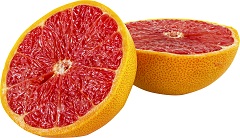
Grapefruit seed extract is similar to tea tree oil in that it is an expensive but very effective natural mold killer. The advantage of grapefruit seed extract over tea tree oil however is that it has almost no odor. Like tea tree oil you can buy grape fruit seed extract from most health food stores.
Grapefruit seed extract kills mold naturally as the citric acid from the grapefruit attacks mold. Grapefruit seed extract also disinfects areas and deodorizes as well. Like tea tree oil, a small amount of grapefruit seed extract goes a long way in killing mold.
How to Kill Mold with Grapefruit Seed Extract
- To kill mold with grapefruit seed extract create a solution of grapefruit seed extract and water in a spray bottle in the ratio of 10 drops of grapefruit seed extract per cup of water.
- Shake the spray bottle to mix the solution thoroughly and then spray it onto the surface where mold is growing.
- You do not need to rinse the solution away afterwards although you can use a cloth to wipe away the mold and solution after some minutes if you like. The longer grapefruit seed extract is in contact with mold the more it will cut through and kill the mold colony and prevent mold from returning.
- Repeat if needed to more thoroughly remove mold from the surface.
The grapefruit seed extract solution in the spray bottle will remain potent for a long time and can be reused again and again as grapefruit seed extract has a long shelf life.


